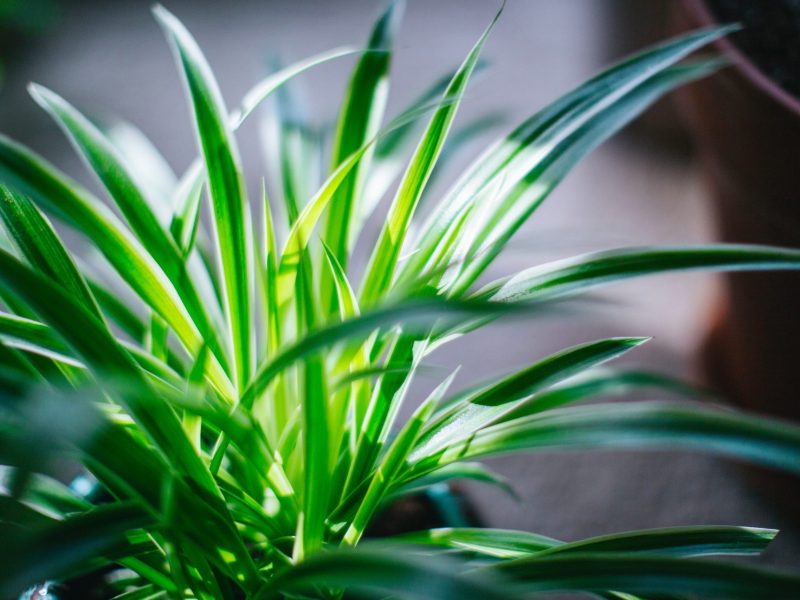
Basic Spider Plant Care
Spider Plants are great and we recommend them to basically anyone looking to add some more greenery to their homes. Not only are they a lot more tolerant of light and moisture conditions than most other houseplant types, but they propagate so easily too!
Ideally, you want to find a spot with bright but indirect sunlight as too much sunlight can fade the leaves and too little can lead to a lack of growth. However, they can adapt well to a wider range than so many other plant types.
Below you’ll find all the information needed to properly care for a Spider Plant. We will also cover FAQs as well as how to spot and treat common problems that might crop up with your Spider Plant.
Detailed Spider Plant Care
Bright indirect light is perfect for Spider Plants
Spider Plants thrive in bright spots but will also adapt to lower light areas. If you are growing a Spider Plant in low light, be aware that growth will be slower and it may not grow spider babies as quickly. Another thing to take into consideration when finding the best spot for your Spider Plant is making sure it does not receive any direct light as this will burn the leaves.
Water moderately but don’t let them become too waterlogged
Overwatering can very quickly lead to root rot. Spider Plants are pretty hardy so overwatering every now and again won’t kill your plant but just be aware of how much you are giving them. Also, make sure to stagger watering your Spider Plant as they prefer to dry out in between waterings.
Spider plants prefer cooler temperatures
Although Spider Plant’s won’t always like to be sat in a really hot home, they are quite easy-going so will survive in most climates year-round. Just try to avoid putting them near draughty doors or windows.
Don’t worry too much about humidity levels for your Spider Plant
One of the great things about caring for Spider Plants is that you don’t need to worry about changing the humidity they are in. They will survive well in the natural humidity levels of your home. Just make sure you are opening the windows each day to allow fresh air to circulate.
Spider plants are very easy to propagate!
Once your Spider Plant matures, they will grow offshoots that will grow into spiderettes that you can separate from the mother plant. Propagation of Spider Plants can also be done via division of the mother plant. Check out our guide to Spider Plant Propagation which includes all the details you need.
Spider plants are safe for pets and children.
Spider Plants are non-toxic to dogs, cats and humans so you don’t need to worry about putting them out of reach for your pets and children.
Spider Plant Care FAQs
How often should I water my Spider Plant?
Spider Plants need to be watered at least once a week during summer and then every 10-14 days during winter depending on the environment.
Are Spider Plants toxic?
Spider Plants are completely non-toxic and safe for pets and humans.
Are Spider Plants easy to care for?
Spider Plants are our top choice for beginner houseplants as they are very easy to care for and adapt to a range of environments making them perfect for every home.
How much sunlight does my Spider Plant need?
Bright indirect light is best for your Spider Plant but it can adapt to lower levels of light too. The one thing to note though is that it won’t produce as many spider babies in lower light levels. Keep your Spider Plant away from direct light as it can fade and burn the leaves.
How often should I fertilise my Spider Plant?
Spider Plants don’t actually need much fertiliser to thrive and you can actually see plenty of new growth without it entirely. If you do want to feed your Spider Plant make sure you only do it during spring and summer a maximum of once a month.
Common Issues for Spider Plants
Whilst Spider Plant are relatively easy to take care of and adapt to most environments, they are prone to some issues. However, if you notice these early and take the right steps, your Spider Plant will more than likely return to a healthy and thriving state.
Why does my Spider Plant have brown leaf tips?
Brown leaf tips on Spider Plants is often caused by over or underwatering. Spider Plants hate sitting in lots of water but need enough to not dry out for long periods of time.
Why are my Spider Plant's leaves drooping?
Drooping leaves on a Spider Plant can often be a symptom of not enough light. Although Spider Plants don’t survive well in direct light, make sure they have a fairly sunny spot otherwise they may start to droop.
Why have my Spider Plant's leaves turned light green?
Spider Plants are great because they often tell you when they are struggling before it is too late. Light pale leaves on a Spider Plant often means that it has not received enough water so make sure to top it up and the colour should return quickly.
Why are my Spider Plant's leaves turning brown / black?
Dark brown or black leaves on your Spider Plant often indicates overwatering. Replace the soil immediately and trim off any dead leaves or rotted roots.














